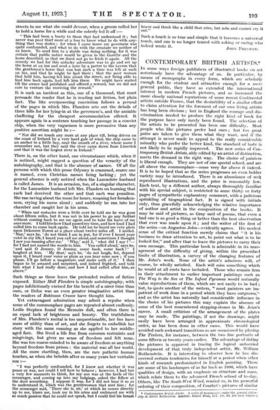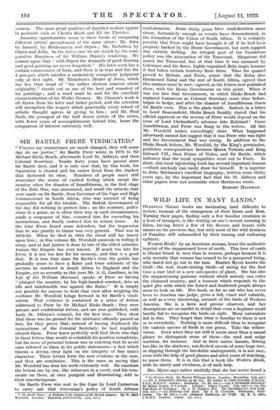CONTEMPORARY BRITISH ARTISTS.*
IN some ways foreign publishers of illustrated books on art notoriously have the advantage of us. In particular, by means of monographs in every form, which are scholarly enough for the student and attractive enough for a more general public, they have so extended the international interest in modern French pictures, and so increased the more closely national reputations of some recent Continental artists outside France, that the desirability of a similar effort to claim attention for the foremost of our own living artists has long been obvious ; but in England the courage and dis- crimination needed to produce the right kind of book for the purpose have only rarely been found. The selection of the artists to be presented has been one difliculty. Most people who like pictures prefer bad ones ; but too great pains are taken to give them what they want, and if the attempt is never made to appeal to the really considerable minority who prefer the better kind, the standard of taste is not likely to be rapidly improved. The new series of Con- temporary British Artists, ably edited by an artist of distinction, meets the demand in the right way. The choice of painters is liberal enough. They are not of one special school, and arc all above the commonplace—some very far above it indeed. It is to be hoped that as the series progresses an even bolder variety may be introduced. There is an abundance of well reproduced illustrations, and the price is reasonably low. Each text, by a different author, always thoroughly familiar with his special subject, is restricted to some thirty or forty pages of sympathetic explanatory comment, with a judicious sprinkling of biographical fact. It is signed with initials only, thus gracefully acknowledging the relative importance of author and artist in the composition of the books. It may be said of pictures, as Gray said of poems, that even a bad one is as good a thing or better than the best observation that ever was made upon it ; and the writer of the first of the series—on Augustus John—evidently agrees. His modest sense of the critical function merely claims that " it is his business to draw attention to art, to point out what is to be looked for," and after that to leave the pictures to carry their own message. This particular book is admirable in its man- agement of the difficulty of giving, within the prescribed limits of illustration, a survey of the changing features of Mr. John's work. None of the artist's admirers will, of course, be wholly satisfied. Each will miss something which he would at all costs have included. Those who remain firm in their attachment to earlier important paintings such as The Way to the Sea or The Infant Pyramus would naturally value reproductions of them, which are not easily to be had ; but, to quote another of the writers, " most painters are im- patient of work done in a period which they have outgrown,'t and as the artist has naturally had considerable influence in the choice of his pictures this may explain the absence of some of the best remembered stepping-stones in Mr. John's career. A small criticism of the arrangement of the plates may be made. The paintings, if not the drawings, might easily have been arranged in approximate chronological order, as has been done in other cases. This would have avoided such awkward transitions as are occasioned by placing The Tinkers, for instance, between the two fine portraits of some fifteen or twenty years earlier. The advantage of dating the pictures is apparent in tracing the logical unhurried development of that truly independent artist, Mr. William Rothenstein. It is interesting to observe how he has dis- covered certain tendencies for himself at a period when other kinds of research predominated in English painting. There are some of his landscapes of as far back as 1906, which have qualities of design, with an emphasis on structure and mass, which relate them to the advanced French school of to-day. Others, like The South-West Wind, remind us, in the powerful ordering of their composition, of Courbet's pictures of similar • Contemporary British Artists. A series of monograph. under the general editor• ship of Albert Rutherston. London: Ernest Denn, Ltd. (85. 60. net each volume.) scenery. The same great qualities of dignified realism appear in portraits such as Charles Booth and Eli the Thatcher.
Amusing opportunities occur in these books of comparing different artists' presentment of the same sitter : Mr. John by himself, by Rothenstein and Orpen ; Mr. Nicholson by Orpen and John. In the latter case we are struck by the com- parative flimsiness of Sir William Orpen's rendering. We cannot agree that " with Orpen the demands of good drawing and good painting are never forgotten." His later work has a certain commonness of form, and there is in tone and line the
peu-pres which satisfies a moderately competent judgment only at first sight. Mr. Nicholson's Master of Jesus, which has less than usual of " his rather obvious concern about originality," stands out as one of the best and soundest of his paintings ; and a word must be said for the excellent characterization of his Walter Greaves. Mr. Clausen's work is all drawn from his later and richer period, and the selection will strengthen the respect which practically every school of artistic thought agrees in giving to him ; and Mr. Paul Nash, the youngest of the half dozen artists of the series, with fewer years of accomplishment behind him, bears the comparison of interest extremely well.



































 Previous page
Previous page